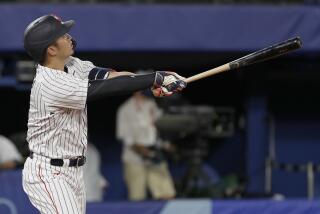Honda Throttles Up to Rescue Sales Title
- Share via
Honda is as mad as hell, and it’s not going to take this anymore.
That’s the uncharacteristic attitude emanating from the Japanese giant of motorcycling after years of being--not unlike its vaunted bikes--strong, reliable and a bit on the quiet side. But the change in ‘tude did not come about--as in political campaigns and dog food advertisements--because of focus groups, surveys or advice from consultants.
The reason is much simpler: After years of dominating motorcycle sales in the United States, Honda slipped to second place in 1999.
“As far back as I remember, they have been No. 1,” said Don Brown, the Irvine-based dean of motorcycle industry analysts. But this year, as The Times reported last week, Brown’s projections indicate that Honda will end up lagging Harley-Davidson by several thousand units.
That’s not entirely a surprise. Harley has been doing spectacularly well since the late 1980s. About 26% of the roughly half-million motorcycles sold in this country come from the Milwaukee-based manufacturer.
“That’s pretty amazing, considering they only build cruisers and touring bikes,” Brown said. Honda and most of the other major manufacturers produce not only those two classifications of motorcycles but also sportbikes, standards and off-road bikes.
*
The other Japanese manufacturers, as well as the Europeans, also have been targeting Honda, intent on taking away some of the giant’s crown jewels.
This year, BMW introduced the K 1200 LT, a luxury touring bike that provides real competition to the machine that essentially invented the genre, Honda’s Gold Wing. Suzuki’s Hayabusa took the fastest-production-motorcycle title away from Honda’s Blackbird, and Yamaha’s R1 stole the limelight in 900-cubic-centimeter bikes from Honda’s CBR900RR. Upstarts such as Polaris’ Victory pose competition as well.
Honda has moved quickly to meet these challenges. Indeed, at its dealer meeting in September, the company’s honchos spoke with uncharacteristic bluntness: “We realize that Yamaha, Polaris and Harley-Davidson have closed the gap in categories that we once dominated,” said Ray Blank, the motorcycle division’s vice president of sales and operation. “And I want each of you to know that their encroachment has not gone unnoticed. Nor will it go unanswered.”
*
Fightin’ words. To back them up, Honda has announced a three-year plan to revamp its lineup, beginning with several new 2000 models, including three street bikes.
The first of the models, the Shadow Sabre VT1100C2, had its official unveiling earlier this year and will be at dealerships in January.
The Sabre, described as a “street rod” cruiser (the motorcycle version of a hot rod), is the least radical of its new offerings, but it is nonetheless impressive.
Honda has been making its Shadow V-twin cruiser line since 1983, its current models being the Aero and ACE. In terms of performance and ergonomics, the Sabre’s departures from these bikes are subtle, but they do add up.
Like its siblings, the Sabre has a 1,099-cc, liquid-cooled engine, but Honda engineers have found ways to tweak its power, giving it noticeable extra oomph in the lower and middle ranges. In test-riding the different Shadow models, I found that I also preferred the ergonomics of the Sabre--its higher foot pegs took a bit of getting used to, but they also allowed me to push back in the seat for a more comfortable ride.
The seat on the Sabre is nearly 1 inch lower than with the other Shadows, which is good news for shorter riders. The handling is certainly acceptable, considering this machine weighs more than 600 pounds.
But unlike sportbikes, in which performance and handling are the main selling points, custom cruisers--designed to allow the rider to individualize the bike with extra chrome and other accessories--are sold on their looks.
“Customs are really all about style,” Honda spokesman Gary Christopher said at the bike’s introduction. The company went for a somewhat retro, slightly bad-boy image with the lowered seat. But the look of the bike is clean, in part to leave room for the accessories the company hopes to sell. When the Sabre hits dealerships, 43 accessories--including extra chrome pieces, floorboards and a passenger backrest--will be available. The base price: $8,199.
In coming months, Honda will deliver its two other new 2000 street bikes: the CBR929RR (to replace the CBR900RR) and the RC51 super-bike. Time will tell how the new offerings fare, but no one can accuse Honda of standing still.
“They have more or less said they will not tolerate anyone beating them,” analyst Brown said. “They aim to come back in grand style.”
*
Two-Wheel Ride surveys the motorcycle scene in Southern California. David Colker can be reached at david.colker@latimes.com.







